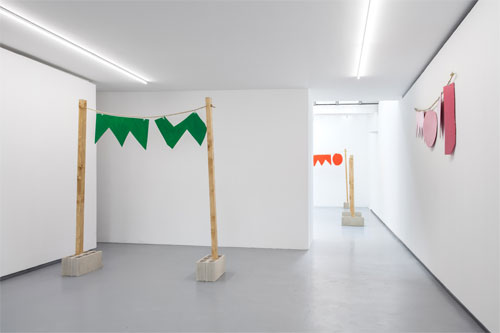FELTON – VALENTIN
STEPHEN FELTON
« Riverside »
At once intuitive and programmatic, Stephen Felton’s pictorial practice initially seems to play with the archetype of the painter’s “inspired” gesture. A few lines of coloured paint applied freehand in one long stroke, on a white or black background, sketch the smooth, schematic contours of a figure. This is what constitutes his “method”, a protocol that supplies a structure within which spontaneity exists like a form of continuous learning, a knowledge of how to let things take their course, more than a passively applied knowhow.
Made with extremely economical means, his semi-pictographic pictorial lexicon is built at the boundary between symbol, signage, automatic drawing, child’s illustration and abstract ornament.
For his new exhibition at Valentin gallery, the artist is extending the principle of his paintings to the field of sculpture: cut-out figures, freed from the painting’s plane, float in space, hanging from strings tied to wooden pillars, building a relational system that depends on architecture, and on real space.
Although these flat, candid, often identifiable shapes evoke systems of visual codes and language, they resist any stable, unequivocal interpretation. They place the “vehicular”, conductive function of painting in a mise en abyme: thus, in Felton’s work, the insistence on the course of the hand echoes a whole range of signs
evoking transportation, crossing and direction (bicycles, vessels, arrows, sails, ladders, roads, stairs, doors). However, the reduction the artist effects does not lead to an essential trait, but to a visual impression that could take many forms (for example, a circle could be seen as a spot of colour, a moon, a wheel, a
punctuation mark, a decorative pattern, etc.).
These clearly approximate shapes are floating, malleable signs. Expressing a relationship more than an image, they acquire their meaning through their use, their reception context, their display, or the relations of proximity between them.
Faced with Stephen Felton’s pieces, sometimes one is torn between two types of reaction. The first detaches the shape like a unit of meaning, then inserts it into a narrative system that the viewer is responsible for reconstructing. It is an approach that is justified by the fact that in producing his pieces, the artist usually takes inspiration from reading experiences, and also speaks of his work in terms of storytelling; each painting is the translation or condensation, into a few aspects, of a textual image that is thus offered as a
fragmentary, elliptical narrative whose syntax the viewer must manipulate in a kind of “language game”.
The other attitude, a “materialist” one, consists in perceiving the figure as the recording of an action, its temporality, its human scale. Presented as totally legible and open, the eyes can re-appropriate its genesis.
By connecting the question of meaning (how a gesture starts meaning something, how a shape gets humanised by meaning, and which common code of reference this involves) with that of production (action as a productive force, an indication of its own temporality, a singularity factor), Felton’s shapes enter into dialogue with the history of painting, questioning the painter’s position, the production of signs, and how they are received. Rejecting any virtuoso, dramatised relationship with his medium, the artist resolutely takes
his place within a generation of painters who have broken with the myth of inspiration, but are not satisfied with the objectivity of minimalist painting, which is too rigid to record the heterogeneity of everyday phenomena.
In Felton’s work, everything is clearly, simply communicable; like language, the everyday activity that determines the painting work conceals no mysterious, strictly “private” territory. This accessibility gives his works a lucidity, a critical obviousness, far from all fascination. The paintings, conceived as vehicles, offer viewers modest but concrete journeys, involving them in an empirical investigation, much more than a search for the absolute, for transcendence.
Text by Clara Guislain.
